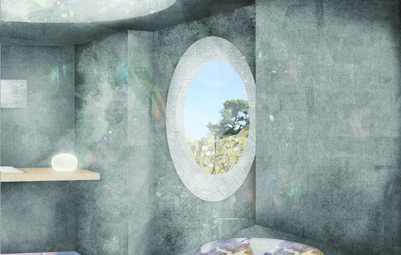
Extract from thesis project by My Comét
Tutor: Katja Bülow
Abstract
Anima Terra (Soul of the Earth/ Earth’s inner self)
In the nature reserve Hilleshögs dalar, on the west coast of Scania, Sweden, the Skåneleden hiking trail takes you along 30-40 m high sand cliffs with a view across Øresund to the west.
Almost hidden beneath these sand cliffs, lies a beach almost completely covered with bricks, nicknamed the ”Brick beach". The bricks are a trace from the old brick industry, Hildesborgs Tegelbruk, that existed in the area between 1806-1967. During this time, the faulty bricks were dumped in the sea just off the coast. These bricks have since been washed ashore, polished through time by sand and water into smooth abstract shapes.
Sweden and its regions work actively with initiatives to attract more people outdoors to improve public health, which is a part of their work with the 3rd UN goal.
In the region of Scania, many of these initiatives have included placing art and architecture along some stretches of the, in total 1300km long, Skåneleden trail.
By using the historical context of the brick industry, together with contextual references, narrative and imagination, while always balancing on the tension between real and imagined, I have designed an installation consisting of 5 spatial sculptures and sculptural spaces, and placed these in the shallow waters by the Brick beach. I have worked with bespoke bricks, challenging our normal perception of bricks in relation to human scale. Both as a method to further evoke imagination through how we reflect the scale of our bodies in what we perceive, but also to shape the structures, which are based on contextual architectural archetypes, stories and myths.
There is also an element of decay included in this installation. As time goes by, the structures will be ruins and the bricks from the installation will join the other washed up bricks - but in shapes that will tell another story than that from the old industry.
Some of the bricks and structures will decay faster than others, as the bricks have different shapes and volumes, and as some of the bricks are glazed - making them more persistent towards the natural elements. Finally, nature will claim the material back to the earth it once came from in its raw form.
By drawing on curiosity and sense of adventure among people to reach the installation, I intend to attract more to visit Hilleshögs dalar and for more visitors to find their way down to the Brick beach and to become curious about the cultural history. Further, the installation is intended to evoke imagination, as well as emotional and sensory values through the spatial experience.

Thesis question
How can stories of a place manifest themselves as physical, spatial creations, to be met by people visiting the site?
Bespoke bricks:
Design:
Storyboard, context and users (images):



















































